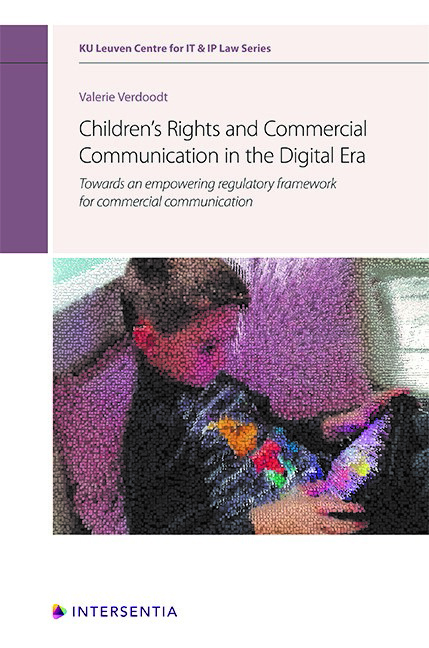 Children's Rights and Commercial Communication in the Digital Era
Children's Rights and Commercial Communication in the Digital Era Book contents
- Frontmatter
- Preface
- Contents
- Abbreviations
- Introduction
- PART I CHILDREN'S RIGHTS AND ADVERTISING LITERACY IN THE DIGITAL ERA
- PART II ASSESSMENT OF THE REGULATORY FRAMEWORK FOR COMMERCIAL COMMUNICATION IN LIGHT OF CHILDREN'S RIGHTS
- PART III ASSESSMENT OF NATIONAL ARIS IN THE AREA OF COMMERCIAL COMMUNICATION
- CONCLUDING REMARKS AND RECOMMENDATIONS FOR THE FUTURE
- Bibliography
- Miscellaneous Endmatter
Chapter III - Recommendations
Published online by Cambridge University Press: 23 July 2020
- Frontmatter
- Preface
- Contents
- Abbreviations
- Introduction
- PART I CHILDREN'S RIGHTS AND ADVERTISING LITERACY IN THE DIGITAL ERA
- PART II ASSESSMENT OF THE REGULATORY FRAMEWORK FOR COMMERCIAL COMMUNICATION IN LIGHT OF CHILDREN'S RIGHTS
- PART III ASSESSMENT OF NATIONAL ARIS IN THE AREA OF COMMERCIAL COMMUNICATION
- CONCLUDING REMARKS AND RECOMMENDATIONS FOR THE FUTURE
- Bibliography
- Miscellaneous Endmatter
Summary
A HOLISTIC APPROACH TO CHILDREN'S RIGHTS AND ADVERTISING LITERACY IN THE DIGITAL ERA. In relation to the fragmentation of and confusion surrounding the regulatory framework for commercial communication, it was concluded that a holistic interpretation is needed. First, this entails that the multidimensionality of children's rights is considered and respected. As described, the reconfiguration of children's rights in the context of commercial communication in the digital era necessitated an interpretation into this specific context. Such an exercise consists of a careful balancing of the objectives of protection, participation and provision. More specifically, it was concluded that from a children's rights perspective, a balance is needed in the context of commercial communication between children's right to protection against harmful or misleading advertising and their right to be empowered, educated and provided with the necessary opportunities to develop their commercial decision-making skills. Moreover, throughout the research it has become apparent that many rights in the digital environment are actually multi-dimensional and should be considered and acknowledged in such a manner at different levels.
Second, it was found that the protections for children in the context of new forms of commercial communication are spread across different instruments (both legislative and self-regulatory). In this regard, it is recommended that emerging advertising trends are evaluated in light of all applicable frameworks in order to attain meaningful protection for children. Furthermore, the different regulatory bodies with competences to enforce advertising-related provisions (both governmental agencies and alternative regulatory bodies) should coordinate their eff orts and work collaboratively on guidance for the implementation of the rules in relation to new advertising formats. Additionally, raising awareness amongst consumers and advertisers of their rights and obligations in this context is also crucial, as it could lead to more consumer complaints, more cases and, hence, more guidelines for advertisers on how to comply with the rules for advertising.
Third, instead of focusing on finding the perfect legal elements for the protection of children in relation to emerging advertising formats, it is suggested that combining all the elements of the regulatory toolbox is the only way to bring the empowerment-protection scales in balance. This toolbox includes inter alia the enhanced enforcement of the regulatory framework, stimulating the collaboration between regulatory bodies and improving the effectiveness of advertising ARIs.
- Type
- Chapter
- Information
- Children's Rights and Commercial Communication in the Digital EraTowards an Empowering Regulatory Framework for Commercial Communication, pp. 301 - 304Publisher: IntersentiaPrint publication year: 2020
